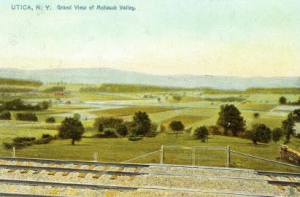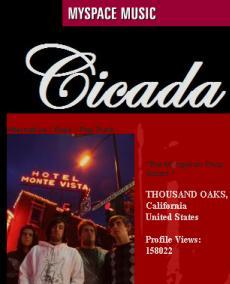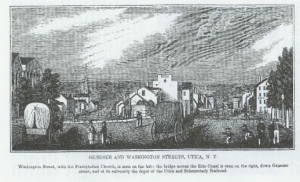Jerrems Family Newsletter
Dear Donald,
released to about 25 subscribers in June 2005. We
are up to 49 subscribers now, scattered around the
globe.
Enjoy the following account of James Jerrems by Ray
with research by Sandra.
Image in header is from a woodblock print of Utica
that
was published in 1841 near the area where travelers
on the Erie Canal would probably have disembarked.
It is very near the scene of both James’ and Joseph’s
arrival in the Utica area.
This image was scanned from a book Sandra
purchased: Oneida
County New York, Compiled from Historical
Collections of the State of New York and Other
Sources by Barbara & Doug Rebok, Tucson, Arizona.
| Remembering James: Father, Farmer, Soapmaker |
Ray Jerrems with Research by Sandra Walcyk
Back to Life in the 1800’s

born in
Wappenham, England, in 1812. It is the story of a
family’s “ups” and “downs”, a theme which seems to
be so typical of families in the 1800s. We have seen it
in Jerrems families in the Gainsborough area and
now we see it again in the United States. It provides a
microcosm of life in those times which would be
worthy of a Charles Dickens novel.
Chronologically it is the third of a series of articles. In
the February edition of the Journal I announced the big
news that Sandra has traced a “new” branch of the
Jerrems family back to Wappenham in
England. Her
great great grandfather Joseph was born in
Wappenham and emigrated to the US in the 1830s.
Joseph was also Sarah’s ancestor. I also related to
you how that branch’s surname had shifted over a
period of time from “Jerromes” to “Jerrams” and finally
to “Jerrems”.
In the March edition I told you a little of the history of
Wappenham.
In this article I will outline to you the story of James,
who was Joseph’s brother. Although in theory it would
have been more logical to talk about Joseph first I
have chosen James because we know more about
him at this stage, the research on Joseph is still in
progress.
You will see that I have threaded the story together
from a number of sources of information. In some
cases I have referred to the sources but mostly I have
not, to keep the article flowing.
Previously I had carried out a fair amount of research
on James, but at that stage I did not know where he
fitted into the “bigger picture” which Sandra has now
provided. Sandra has also supplied a lot of additional
material, particularly the history of the area where
James migrated to in the US. Coincidentally Sandra
grew up in the same area.
The Early Years.
This period in James’s life commences in 1812 and
concludes in the early 1850s.
James was born in Wappenham in 1812, his parents
being William and Hannah Jerrams. To date
we have
no specific information on the Wappenham family but
we have surmised that the family lived on a farm. In
about 1831 James married Ann Carter (who
was born
in England in about 1815) and the couple migrated to
the United States in 1832.
It is very likely that the couple disembarked at New
York, which was the major port used by migrants. One
can imagine their excitement at the wonderful choice
of places available to them in the US to settle in. They
chose the Utica area, about 250 miles to the
north
west of New York City. No doubt a major attribute of
that area was that it was now comparatively easy to
get to from New York City and it had good employment
opportunities.
The reason for this ease of access was that they
could travel by boat along Erie Canal. The good
employment opportunities arose from Utica’s growth
as an industrial city. Also there were a number of
textile mills at the nearby village of Washington
Mills.
Initially James and Ann lived in Utica, until at
least
1843, but it was in the Washington Mills area
that they
finally settled. James probably worked in the mills
initially but later took up soapmaking, a
somewhat
unusual vocation for someone who had grown up in a
rural area. It is therefore likely that James learnt the
ropes by working for a soapmaker in the Utica area
and then bought the necessary heating vats to go into
business by himself.
James would have found a ready market for his soap
in the nearby textile mills and in the factories and
households in Utica. We think of soap as being used
for domestic purposes but in the days before
detergent was invented soap was used for industrial
purposes also. Soapmaking was not a healthy
occupation because the vats were filled with animal
fat and caustic soda and this witches brew had to be
boiled for at least two hours. The steam would have
been mildly toxic. He obviously felt that his soap was
superior because he exhibited barrels of his soft soap
in at least two County fairs, the first being the New
York State Fair in 1852.
Meanwhile James and Ann had been busy following
the principle of “populate or perish”. In the space of 13
years they had eight children, James H., born
1837-38
(died 1872), Thomas W., born 1839 (died 1918),
Jessee or Jesse, born 1840 (died 1866 from
consumption, now called tuberculosis), Elizabeth,
born 1841, Josephine born 1843 (died 1852 from
scarlet fever, a staph infection), Rebecca, born 1845,
Emma born 1850 and Helen born 1851 (died 1852
from dysentery).
The soapmaking business gradually built up. In the
1850 Census James showed the value of his real
estate as $1500 and in the 1860 Census he showed
it as $5000.
The nearby plank road on Oneida Street would have
given James quick access to the city of Utica, to take
soap to shops and factories and bring back the
necessary raw materials for production of more soap.
The Turbulent Years.
We now see a change in tempo in the period between
the early 1850s and the late 1860s. The family had a
rollercoaster ride with, unfortunately, many downhill
sections. We do not know the precise sequence of
events in some cases, but I have put them in
numbered paragraphs to make the events easier to
follow:
(a) Ann, after populating so
capably, perished in 1852 from consumption.
(b) James married again in early
1853, marrying a widow, Esther Colbrook,
who was
born in England in 1820. Esther had had 3 children by
her previous marriage to Robert Colbrook (the
children being Robert, Sarah and Harriet). Sarah
joined James’s household but it is not clear whether
Robert and Harriet did likewise. James and
Esther
had five children, Mary, born 1853, Anah born 1854
(died 1856 from croup, a respiratory complaint),
George, born 1856 (died 1859), and Charles, born
1858 (died after 1920). They also had a daughter
Esther who was apparently Charles’s twin
and died
from convulsions the day after birth. Finally James’s
wife Esther died in 1860 from consumption. This
meant that James had lost two wives through
consumption (a common cause of death, James’s
sister in law also died of consumption in Utica), and
he outlived about half of his children. It is tempting to
surmise that the “consumption” was a lung disease
caused by the soapmaking fumes.
(c) At some time in the 1850s
James moved several miles to a farm at nearby New
Hartford, where he took up farming with the help of his
eldest sons James, Thomas and Jesse. The
reason
for moving was probably a combination of a desire by
him to go back to his farming roots, the need for more
room for his expanding family, and the increased
scope for training his children. No doubt his
neighbours were happy to see him take his
soapmaking vats with him.
(d) A serious downside of the new
location was that little George (aged three) was killed
in a tragic accident in the farm stable in 1859.
(e) The new location favoured the
family in other respects. The 1860 Census shows that
the neighbours were mostly farmers or farm workers.
A neighbour was a blacksmith, where James junior
probably served his apprenticeship and later worked,
finally marrying the blacksmith’s granddaughter.
(f) Another son,Thomas, gained experience
on the family farm, including working the horse team,
and on other farms in the area. His love of horses
and his farm experience stood him in good stead in
later life.
(g) James kept his hand in at
soapmaking, exhibiting a barrel of soft soap at the
1860 Oneida County Fair.
(h) In 1861 these farming
activities were interrupted by the commencement of
the American Civil War. The three eldest sons, their
step brother Robert Colbrook and their close
friend
Thomas Mayborn signed up, and Jesse died
soon
after the War. Although James was no doubt proud of
the boys serving in the war it would have left him short-
handed on the farm, with only the eldest girls to help. I
will tell you about the boys’ Civil War experiences in a
separate article.
(i) The labour shortage on the farm
continued after the Civil War. James Jnr (the
blacksmith) married Emma Newkirk and they
went to
Valley near Lawn Ridge, Illinois. Thomas married
Theresa Autenreith in about 1862 and moved
to
Plainfield near Chicago, Illinois, and Robert Colbrook
moved north. This was the start of a family exodus.
The Quiet Years
This period begins in the mid 1860s and concludes
with James’s death much later in Kansas.
James’s third (and final) wife was Caroline
Mayborn
(nee Harding), who was born in England in 1822. And
where did they meet? Therein lies a story. Listen
carefully.
After being wounded in the Civil War Thomas Mayborn
(a friend of James Jnr, Thomas and Jesse) married
Rebecca, one of James’s daughters. In an interesting
twist James then married Thomas Mayborn’s
widowed mother Caroline. In brief terms James
married his daughter’s mother-in-law. Got that?
Fortunately for Caroline she did not follow
the “populate or perish” adage. In 1866 she had one
child, Minnie, and lived to tell the tale.
James and Caroline were married in Essex, Illinois
and Minnie was born there. Presumably they moved to
Essex after James had sold the farm at New Hartford.
Both James and Caroline had lost their previous
spouses in the Utica area, perhaps they wanted to
start afresh. They then moved several more times, as
follows:
(a) In 1870 they lived in Akron,
Illinois (about 200 km west of Essex) with Emma,
Mary, Charles and Minnie. James described himself
as a farmer. Possibly this was a smaller farm easier
for James to operate. This was only 10 km from where
James Jnr lived, so it seems that James Snr moved
there to be near James Jnr, or vice versa.
(b) In 1880 they returned to the
Essex area (the village of Wyoming) with Minnie.
James had finally hung up his farming boots,
describing himself as a gardener.
(c) In the 1890s they lived in
Lanham in Kansas, only a mile from where their
children Rebecca and Thomas Mayborn lived (no, I
did not forget the 1890 Federal Census, all the 1890
US Census records were accidentally destroyed).
(d) Finally, James died in Kansas
in 1895 at the grand old age of 83, despite the
dangers of his earlier soapmaking activities. Caroline
outlived him, dying in 1903 at the age of 81. They were
both buried in St Johns Cemetery, Lanham. If you are
in the area call in with a bunch of flowers and say
hello, they are in Plots 5/2/2 and 5/2/3.
Conclusion
I think that you will now agree with my earlier comment
that James’s story is worthy of a Dickens novel. It is a
story of enterprise and fluctuating fortunes.
Thank you to Sandra for her hard work in building on
my original research and for providing the post card
images.
=======================
EDITOR’S NOTE:
We have a sequel with more pictures taken by Sandra
when she visited the Forest Hill Cemetery with
Jerrems gravestones.
Is it a coincidence that the Wappenham family
migrated from the UK in the early 1800’s and
eventually to the midwest (Illinois) and that the Aussie
branch also to the midwest (Chicago) in the mid-to-
late 1800’s? I wonder if there was a family connection.
Were they aware of each other’s presence? If you have
any insight, send us a note.
| Mystery Behind the Rooster Shawl |
Donald Jerrems, Editor, Ray Jerrems, Mystery Solver
Another Surprise From our Email Bag

Longstanding readers may remember the still life
paintings of a red melon and a rooster pictured in the
January 2007 Edition of the Journal. They
accompanied an article titled: “Leonore Jerrems and
The Mystery Masterpieces”.
In the article I described how I had found the paintings
(via Google) in a 2004 Art Gallery Auction Catalogue.
At the time I had never heard of the painter,
Leonore
Smith Jerrems, and I was particularly intrigued by
the
multi-coloured backdrop in the rooster painting.
Well, I can now tell you that the backdrop to the rooster
painting was a shawl. And how do I know
this?
Because a new reader of the Journal has the
actual
shawl, and it has been handed down to her.
So who has it been handed down to? None other than
a grand daughter of Leonore Smith Jerrems,
also
named Leonore. Here is her recent email to Donald,
our Editor:
“Greetings from Leonore, the granddaughter of
Leonore and Arthur Wallace Jerrems Jr. I was
searching my grandmother’s name on the web and
came across your family newsletter. What a surprise
to read the article about my grandmother and the
mystery masterpieces! I happen to have the shawl
that
forms the backdrop to the rooster picture.
I have enjoyed reading about the fascinating Jerrems
family and sharing the news with my mother, brothers,
sister, children, nieces and nephews. My mother,
Mary, has four children and nine grandchildren.
She is very interested in family history and would love
to hear from you. She would be pleased to share her
memories and find out more about her father’s family.”
Mary M. Martin,
York Harbor, Maine
Best wishes,
Leonore (Lee) M. Neary
Glen Ellyn, IL
Leonore and I have subsequently exchanged emails
and Donald sent a birthday card to Mary for her 80th
birthday which, coincidentally, was celebrated in July.
But I will tell you more about these events in future
issues of the Journal.
Meanwhile, isn’t it exciting that we are gradually
picking up more family members through people
googling the Journal’s website? And such
enthusiastic readers into the bargain!
Followup:
We sent Mary a Streetmail Greeting card for
her 80th birthday in mid-July; it was the December
2005 Jerrems Journal Christmas card (edition 8) that
included greeting and pictures from many of our
subscribers at the time. A bit out of season but very
sentimental.
| Administrivia |
Donald Jerrems, All-Purpose Editor, Producer and More.
Reflecting on the Future and the Past

Just wanted to give you a little more news for the
Jerrems Journal. My brother Nick and his
band Cicada
are actually doing a 3 week gig right now around CA.
It’s pretty exciting. It’s their and Nick’s first tour ever.
My dad Steve is along with them, driving them
everywhere. You can get more info on where they are
going, they have pictures and video blogs too, on their
myspace, http://www.myspace.com/cicadaca. Plus
they just had another c.d. come out.
Upcoming Shows: Jul 27 2008 7:00P The
Outer Rim – All Ages w/Phoenix Rising, All Time
Ending, Motif Onyx, The Boomsticks, and Soultree Salt
Lake City, Utah.
Jul 28 2008 8:00P The Chaos Cafe – All Ages Show
with The Rainy States!!! Portland, Oregon.
Jul 29 2008 7:00P Rock N Roll Pizza – All Ages Show
w/Aerodrone, Neon Culpa, Lords & Kings and Ninjas
With Syringes Portland, Oregon.
Jul 31 2008 9:00P Mt Tabor Legacy w/ Neon Culpa
Portland.
=======================
We will schedule a Celebration Issue later
this year. With that thought in mind, send us a
Jerrems story or a picture for the Remember Us
Series.

